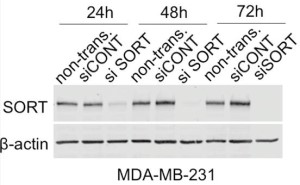Overview
- Peptide DKDTTRRIHVSTDQGD(C) corresponding to amino acid residues 320-335 of human Sortilin (Accession Q99523). Extracellular domain.

 Western blot analysis of mouse (lanes 1 and 3) and rat (lanes 2 and 4) brain lysate:1,2. Anti-Sortilin (extracellular) Antibody (#ANT-009), (1:400).
Western blot analysis of mouse (lanes 1 and 3) and rat (lanes 2 and 4) brain lysate:1,2. Anti-Sortilin (extracellular) Antibody (#ANT-009), (1:400).
3,4. Anti-Sortilin (extracellular) Antibody, preincubated with Sortilin (extracellular) Blocking Peptide (#BLP-NT009).
 Expression of Sortilin in rat neocortexImmunohistochemical staining of rat neocortex with Anti-Sortilin (extracellular) Antibody (#ANT-009). A. Sortilin appears in cortical neurons (red). B. Staining of interneurons with mouse anti-parvalbumin (PV, green). C. Confocal merge of Sortilin and PV demonstrates separate localization in neocortex.
Expression of Sortilin in rat neocortexImmunohistochemical staining of rat neocortex with Anti-Sortilin (extracellular) Antibody (#ANT-009). A. Sortilin appears in cortical neurons (red). B. Staining of interneurons with mouse anti-parvalbumin (PV, green). C. Confocal merge of Sortilin and PV demonstrates separate localization in neocortex.
- Petersen, C.M. et al. (1997) J. Biol. Chem. 272, 3599.
- Mazella, J. et al. (1998) J. Biol. Chem. 273, 26273.
- Nykjaer, A. et al. (2004) Nature 427, 843.
- Teng, H.K. et al. (2005) J. Neurosci. 25, 5455.
Sortilin is a member of the Vps10p family named for a yeast gene that is involved in trafficking between the trans-golgi network and the vacuole. In mammals sortilin has been shown to play an important role in golgi to endosome and golgi to lysosome trafficking. Sortilin is also known as neurotensin receptor 3 (NTS3), one of the receptors for the peptide neurotransmitter neurotensin that exerts several biological functions ranging from the regulation of dopamine transmission and pain in the central nervous system to its functioning as a local hormone affecting the gastrointestinal tract. In addition, sortilin has lately been identified as a co-receptor of p75NTR for the binding of the proneurotrophins proNGF and proBDNF. Moreover, sortilin expression was found to be essential for proNGF and proBDNF-induced neuronal cell death.
Sortilin is a type I membrane protein with a large extracellular domain that includes 8 bacterial neuraminidase repeats (BNRs), a single transmembrane region and a short cytoplasmic tail. The protein is expressed in several tissues, most notably in the brain, spinal cord, skeletal muscle and adipocytes.
Paradoxically for its role as either a neurotensin receptor or a p75NTR co-receptor for proneurotrophins, about 90% of sortilin is retained in intracellular compartments with only about 10% reaching the cell surface. It has been speculated, that changes in the cellular environment may increase cell surface expression of sortilin.
Application key:
Species reactivity key:
Anti-Sortilin (extracellular) Antibody (#ANT-009) is a highly specific antibody directed against an epitope of the human protein. The antibody can be used in western blot, immunohistochemistry, and live cell flow cytometry applications. It has been designed to recognize Sortilin from mouse, rat, and human samples.

Knockout validation of Anti-Sortilin (extracellular) Antibody in siRNA-treated human MDA-MB-231 cells.Western blot analysis of human MDA-MB-231 breast cancer cells with Anti-Sortilin (extracellular) Antibody (#ANT-009). Sortilin immunodetection is shown under non-transfected conditions, siCONT, and si SORT at different time intervals. Clear and significant down regulation of Sortilin expression is observed at 24h, while no detection is observed 72h after si SORT treatment. Adapted from Roselli, S. et al. (2015) Oncotarget 6, 10473. with permission of Impact Journals.
Applications
Citations
- Western blot analysis of human MDA-MB-231 breast cancer cells. Also tested in siRNA treated cells.
Roselli, S. et al. (2015) Oncotarget 6, 10473.
- Human MDA-MB-231 breast cancer cells. Also tested in siRNA treated cells.
Roselli, S. et al. (2015) Oncotarget 6, 10473.
- Urban, D. et al. (2013) J. Biochem. 153, 197.

